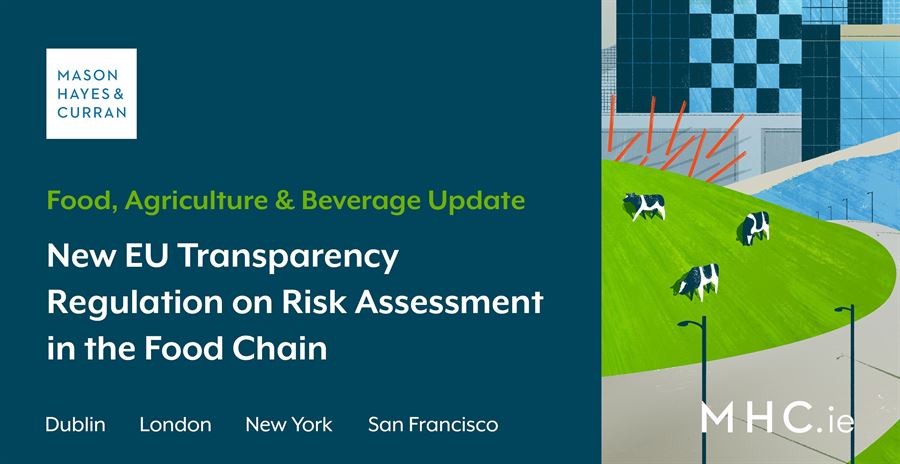
EU Regulation 2019 /1381, the new regulation on transparency and sustainability of EU risk assessment in the food chain (the Transparency Regulation) came into effect on 27 March 2021. It aims to strengthen citizens' trust that the risk analysis procedure for food ensures a high level of protection of human health and consumers' interests. Under the General Food Law Regulation 178/2002, the European Food Safety Authority (EFSA) is entrusted with the role of risk assessor, evaluating risks associated with the food chain. The EFSA does not ordinarily carry out its own primary research, instead collecting and analysing existing research and data in order to produce independent scientific advice and opinions for use by EU institutions and national food safety authorities.
There are four key areas to the Transparency Regulation:
-
Greater transparency of the EU’s risk assessment in the food chain
-
Increased independence of scientific studies
-
Strengthened governance of EFSA and scientific cooperation
-
More comprehensive and effective risk communication
Does the regulation change existing legislation?
The Transparency Regulation amends the General Food Law Regulation and amends certain articles of other EU laws which deal with specific food types:
-
GMOs
-
Feed additives
-
Smoke flavourings
-
Food contact materials
-
Food additives
-
Food enzymes and flavourings
-
Plant protection products and
-
Novel foods
Greater transparency
The Transparency Regulation is a direct result of concerns that arose regarding the EFSA’s risk assessment of the pesticide glyphosate, where the EFSA relied on studies commissioned by the industry and submitted in authorisation procedures, rather than on independent studies. In fact, the European Citizens' Initiative on banning glyphosate as a pesticide is name checked in the recitals of the Transparency Regulation. All studies and information supporting a request for a scientific output by the EFSA will need to be made publicly accessible on the EFSA’s website. This will be done at the very early stage of the risk assessment process. The EFSA will be able to consult with the public and all other partners before preparing its scientific output.
Public access versus confidentiality
Under the Transparency Regulation, all scientific data, studies and other information supporting applications to the EFSA will be made public proactively, with the exception of duly justified confidential information. Confidentiality requests may only be submitted to the EFSA in relation to information falling within the closed list of confidential items. Applications for confidentiality will have to be substantiated by evidence that disclosing the information would potentially harm the applicant’s interests to a significant degree. When an applicant submits a dossier, it may request certain parts to be kept confidential. Within 10 weeks of being submitted, the EFSA will assess the confidentiality claim. The EFSA will then publish a non-confidential version of the submitted studies and information.
The mandatory publication of studies conducted by food businesses has given rise to concerns that it will undermine R&D by food companies, allow competitors to learn of innovations being developed by an EU food business, and may ultimately reduce innovation in the European food market. Industry stakeholders will be watching closely whether the confidentiality provisions are sufficient to protect their investment in innovation, or if the mandatory publication of scientific studies becomes a gift to their competitors.
Increasing the independence of studies
The EFSA will be notified of all commissioned studies to guarantee that companies applying for authorisations submit all relevant information and do not hold back unfavourable studies. In addition, the EFSA will provide general advice to applicants prior to the submission of the dossier. The Commission will be given the power to carry out fact-finding missions at laboratories.
Risk communication
The Commission will adopt a general plan on risk communication by means of an implementing act which is currently being prepared by the Commission and the EFSA.
The governance role of the EFSA
The EFSA is an independent European agency that operates separate to the EU institutions. The Transparency Regulation will increase the EFSA’s governance role and it will be charged with managing a publicly accessible database that will contain details of all studies and information commissioned or carried out by businesses to support an application or notification made to the EFSA. Under the Transparency Regulation, a new EFSA Management Board will be operational from 1 July 2022. It will consist of representatives of all EU Member States, the Commission, the European Parliament as well as members from industry bodies. Each Member State will need to nominate a representative to the EFSA Management Board.
Conclusion
The aim of the Transparency Regulation is to provide EU citizens with greater confidence in the safety of chemicals that find the way into the food chain. In terms of next steps, the European Commission, EFSA and Member States are currently developing a general plan to ensure coherent risk communication throughout the risk analysis process. The Transparency Regulation applies in Member States since 27 March 2021. However, the provisions relating to the Management Board will apply from 1 July 2022.
What impact will this have on businesses?
As the Transparency Regulation will introduce new processes and tools to a wide range of food sectors, this will have a significant impact on food businesses involved in or affected by risk assessments conducted by the EFSA. Food businesses will need to be aware of the new requirements on transparency, the specific requirements to apply for confidentiality, and to keep under review the impact that mandatory publication of scientific studies has on innovation and new product development in the sector.
For more information on the impact of the Transparency Regulation on your business operations, contact a member of our Food, Agriculture & Beverage team.
The content of this article is provided for information purposes only and does not constitute legal or other advice.




